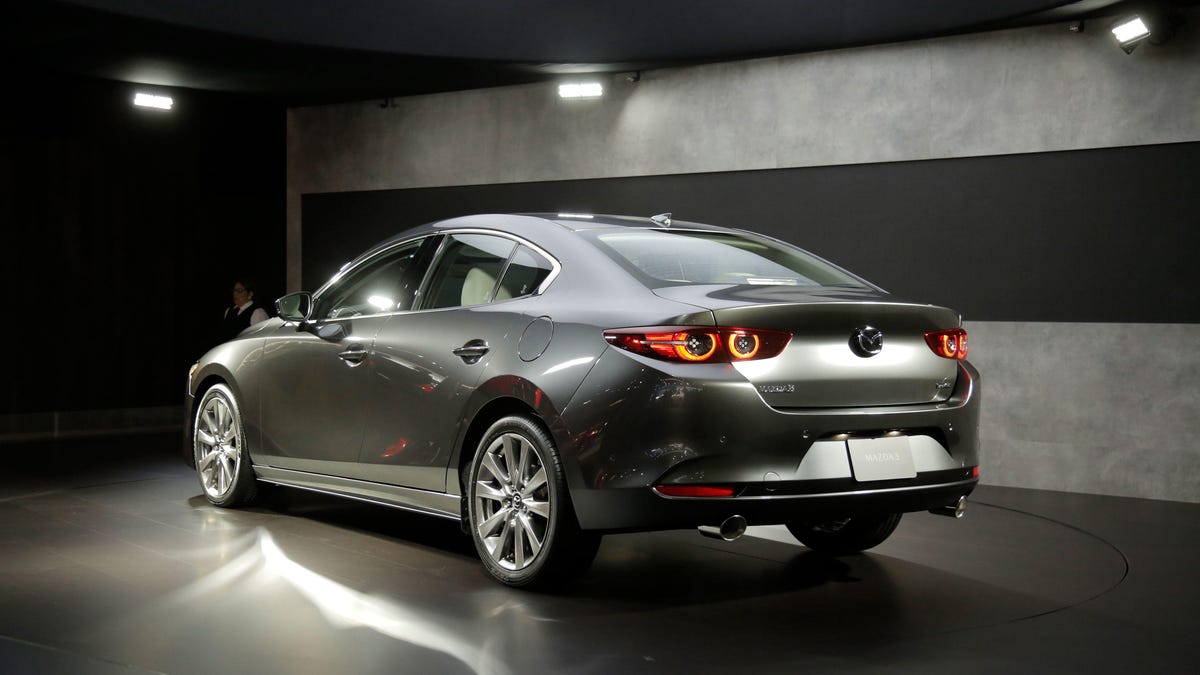2019 Mazda3 debuts at LA Auto Show with Skyactiv-X tech
Beneath the new minimalist design, you'll find smarter safety features and the first appearance of Mazda's Skyactiv-X engine technology.

Mazda has unveiled its fourth-generation of its Mazda3 compact sedan and hatchback at the 2018 Los Angeles Auto Show. The new models boast a simplified aesthetic, new driver aid and infotainment tech evolutions and will be the first vehicles to feature the automaker's new Skyactiv-X engine technology when it goes on sale next year.
'Less is more' design
For the new Mazda3 sedan and hatchback models, Mazda's designers took a minimalist approach. The 3's profile features no character lines, strong creases or hard edges. Instead there are just flowing, smooth curves that Mazda uses to convey elegance, emotion and muscularity.
The hatchback pulls off the new design language best with a dramatic, massive C-pillar that gives the car a very dynamic appearance. It's probably also got a fairly massive blind spot and seems a bit oddly proportioned from certain angles.
The sedan is the more bland of the two. Without the benefit of hatch's weird proportions to draw the eye, the Mazda3 sedan's flanks end up looking sunken, undefined and just sort of blobby.
Both body styles feature sharp front and rear end design elements that continue to evolve and simplify Mazda's Kodo design language and add some structure to their undefined midsections. I'm not feeling "love at first sight" for either of the 3s, but I'll reserve judgement until seeing both cars in person.
Simple, smart cabin
Inside, the "less is more" theme continues with a driver-focused cockpit with many subtle ergonomic tweaks that underpin a simplified, minimalist dashboard design.
The steering wheel now boasts more telescoping range to better accommodate various body shapes. Meanwhile, the shifter position (for both manual and automatic models) has been moved forward and upward for an easier reach from and return to the steering wheel. Standard seat cushion tilt comes to a new overall bucket seat design that claims better spinal alignment for comfort and improved road feel.
Ahead of those new seats is a handsomely minimal dashboard that integrates the handful of vents, buttons and knobs for the climate controls into its two-tiered design. Embodying the brand's new "Mazda Premium" push, the new Mazda3 will be available with upgraded trim materials including a new Burgundy leather colorway exclusive to the hatchback.
An 8.8-inch widescreen display for the Mazda infotainment system sits atop the dash and is operated by a physical control knob on the center console. Presumably, this version of Mazda Connect will feature the recently announced Android Auto and Apple CarPlay connectivity, but the initial announcement makes no mention of these technologies.
The inside of the 3 looks just as stylish the exterior.
i-Activsense safety technology
Expect the current i-Activsense suite of driver aid technologies to persist into this new generation with a few fresh features added to the mix.
The new Mazda3 will be available with an infrared camera-based Driver Monitoring System that watches the driver's eyes and lids to make sure they are watching the road while driving. IR LEDs invisibly illuminate the driver's face in the dark, making this technology particularly useful for preventing drivers from dozing off at the wheel at night.
A new Cruising & Traffic Support system assists with accelerator, brake and steering input to reduce fatigue in highway traffic jams. Presumably, like Audi's Traffic Jam Assist feature, this is hands-on steering assist while the car handles accelerating and braking to maintain a safe following distance.
There's also a new Front Cross Traffic Alert system that uses side-firing radar to detect oncoming perpendicular traffic at blind intersections or when nosing out of an alley or garage into traffic.
Just look at the size of that C-pillar! I hope blind-spot monitoring is standard this year.
Skyactiv engine tech
Under the new sheet metal, the new Mazda3's body is, of course, stiffer, stronger and lighter, bringing improvements to handling thanks to stronger suspension mounting points, improved crash safety, better economy and a quieter ride. And under the hood, the next-generation Mazda3 will launch with a variety of Skyactiv-G and D engines globally.
However, North American drivers only need concern ourselves with the Skyactiv-G 2.5-liter four-banger that we're getting at launch in early 2019. Power and torque have not yet been stated, but expect something in the ballpark of the 184 horsepower and 185 pound-feet of torque that the current 2.5-liter makes. It'll be available with either a six-speed manual transmission or a six-speed automatic sending power to the front wheels. Additionally, Mazda's i-Activ all-wheel drive system will be available for this generation with G-Vectoring Control Plus brake-powered torque vectoring.
In late 2019, Mazda's next-generation Skyactiv-X engine with M Hybrid system will debut, joining the Mazda3's options list globally with the promise of better torque delivery and improved fuel economy with little-to-no impact on driving dynamics and fun. Unlike the simplified exterior design, Skyactiv-X is extremely complicated stuff, throwing together ultra-high compression, a small supercharger, complex combustion timing, technologies derived from diesel engines and even a mild hybrid system. I've already nerded out over this engine technology and how it works in a separate article, so you can learn more about Skyactiv-X there.

